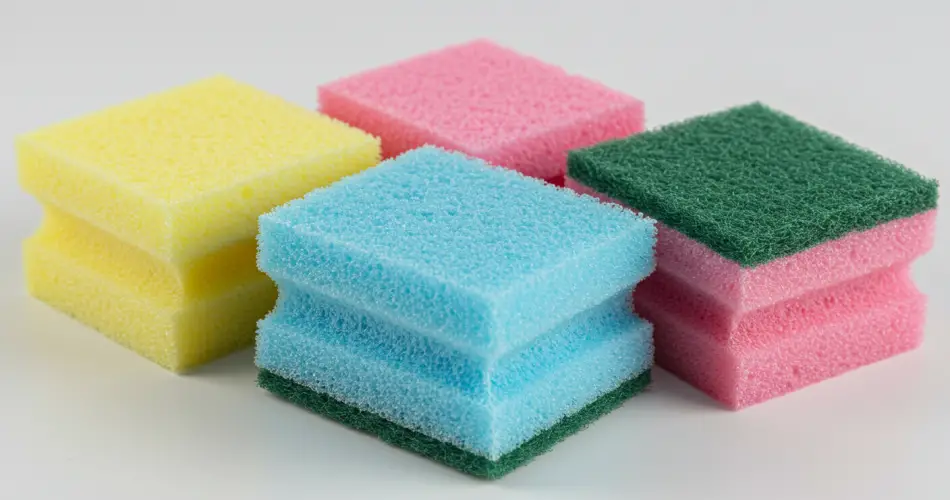After every meal, the task of washing dishes often feels like a chore that most people would rather postpone. Yet, leaving dirty plates and pots stacked up on the counter is not only unsightly but also makes cleaning harder later on. Food residues harden, grease clings to surfaces, and scrubbing becomes a test of patience. That’s why experts always recommend washing dishes soon after eating—or at least rinsing off the food particles if you plan to clean them later.
For households without a dishwasher, this routine is even more essential. Without the convenience of an appliance to do the hard work, cleaning dishes relies entirely on elbow grease, quality dish soap, protective gloves, and—above all—a good kitchen sponge. This simple tool is often underestimated, yet it plays a key role in making sure your plates, glasses, pots, and pans return to their sparkling best.
But what if there was a clever way to use your kitchen sponges differently, extending their life and increasing their effectiveness? A small but brilliant hack can help you achieve just that. Let’s explore how you can transform a simple sponge into a versatile cleaning tool that tackles even the most stubborn messes.
Why the Humble Kitchen Sponge Matters
Kitchen sponges are usually made of cellulose, a material that is highly absorbent and perfect for generating the foamy lather that dish soap needs to lift grease and dirt. On one side, most sponges have a soft, porous surface suitable for delicate cleaning tasks. On the other, the rougher scouring pad helps scrub away tough residues and burnt-on food.
This dual function makes sponges invaluable—not only for washing dishes but also for cleaning the sink, countertops, stovetops, and other kitchen surfaces. However, as with all frequently used cleaning tools, sponges don’t last forever. They wear out, lose effectiveness, and can quickly become a breeding ground for bacteria.
For hygiene reasons, experts recommend replacing a kitchen sponge every two to three weeks. A fresh sponge ensures both efficiency and safety, reducing the risk of spreading germs. Yet, before discarding your old ones, you may want to consider giving them a second life—or even modifying new sponges to make them more effective for specific cleaning jobs.
The Clever Sponge Trick You’ll Wish You Knew Earlier
The trick is simple: by cutting your sponge strategically, you can create new shapes and functions that make cleaning easier. With nothing more than a utility knife or a sharp blade, you can turn an ordinary sponge into a multi-purpose tool.
-
The Sink Holder Cut
Instead of leaving your sponge lying flat on the counter—where it stays damp and attracts bacteria—you can cut a small notch into one side of the sponge. This notch allows the sponge to slot neatly onto the edge of your sink. Not only does this keep the sponge in place, but it also helps it dry faster between uses, prolonging its life and improving hygiene. -
The Grate Cleaner
Grates, racks, and other uneven surfaces are notoriously difficult to clean. By cutting slits into the sponge, you create flexible edges that can slip between narrow gaps and scrub more effectively. This method works particularly well for oven racks, grill grates, or even the spaces between tiles. -
The Mini Sponge with Handle
Remember the piece you cut out to create a sink holder notch? Don’t throw it away. You can repurpose it by attaching it to a small wooden stick or skewer. This creates a tiny sponge-on-a-stick, perfect for reaching into narrow glasses, bottles, or containers where your hand won’t fit. Simply secure the sponge fragment with a rubber band or glue, and you have a lightweight, reusable cleaning tool. -
The Folded Sponge Brush
For particularly narrow spaces, you can cut a sponge in half, fold it, and secure it with an elastic band. Insert a small stick or even a chopstick through the fold to create a mini cleaning brush. This makes it easier to clean inside thermos flasks, baby bottles, or decorative vases with narrow necks.
Why This Hack Works
The real advantage of this trick is that it maximizes the value of a product you already use every day. By adapting a sponge’s shape, you tailor it to fit specific cleaning challenges, saving time and effort. Instead of struggling with tools that aren’t designed for tight or uneven spaces, you let the sponge do the work with its flexibility and absorbency.
Additionally, these hacks reduce waste. Instead of discarding sponges as soon as they lose their original shape, you can repurpose them for alternative uses. Even a worn sponge can still be useful for cleaning outdoor furniture, shoes, or car interiors.
Hygiene Considerations
While modifying your sponges can extend their usefulness, hygiene should remain a top priority. Always rinse sponges thoroughly after each use and wring out excess water to prevent bacterial growth. You can also sanitize them occasionally by soaking them in a vinegar solution, microwaving them for one minute while damp, or running them through the dishwasher on a hot cycle.
Once the sponge becomes too worn or emits an unpleasant odor despite cleaning, it’s time to discard it. Remember: sponges are inexpensive, but health is priceless.
Final Thoughts
The kitchen sponge may seem like the simplest tool in your cleaning arsenal, but with a little creativity, it can become far more than a standard dish scrubber. By cutting, reshaping, and repurposing it, you can tackle tricky cleaning jobs, reach hidden spaces, and even make your sponge last longer.
Next time you pick up a sponge, don’t just see it as a disposable item—see it as a versatile cleaning ally. With this clever trick, you’ll not only improve your cleaning routine but also save money and reduce waste. Sometimes, the most effective solutions are hidden in plain sight.



